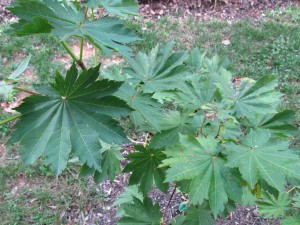Ullung-do Island Korean maple (Acer pseudosieboldianum ‘Takeshimense’) is a small deciduous tree which will grow to be 20 -25 feet tall tree, with a spread of 15-18 feet. It tends to branch low to the ground. It originates from the Ullung-do Island in the sea of China.
Korean maple is one of the best maples for fall color in the Southern Appalachian region (USDA zones 6 and 7). For a short time, new spring foliage emerges with a reddish tinge. Its forest green foliage lasts all summer long and stays disease and pest free. Autumn leaf colors are exceptional with reds, oranges and yellows throughout the tree.
It features subtle clusters of creamy white flowers with purple bracts rising above the foliage in early spring before the leaves appear. The two winged samaras turn purple in mid-summer. The rough gray bark and brick red branches add an interesting dimension to the winter landscape.
Korean maple excels in full sun in northerly areas (USDA hardiness zones 4) where few Japanese maple (A. palmatum) cultivars, if any, will grow. In northerly areas Korean maple grows in full sunlight and a compost rich, well-drained, and slightly acidic soil. Further south (zones 6 and 7), partial day or full morning sunlight is the rule. The tree shouldn’t be permitted to dry out. Irrigate during extended dry periods and cover the ground with 2-3 inches of mulch.
This is a relatively low maintenance tree, and is best pruned in the summer after the leaves have fully developed. Korean Maple is an open multi-stemmed low canopy deciduous tree which makes it ideal for planting under power lines.
Availability of Korean maple is limited to e-commerce nurseries on-line.


 Posted in
Posted in 
